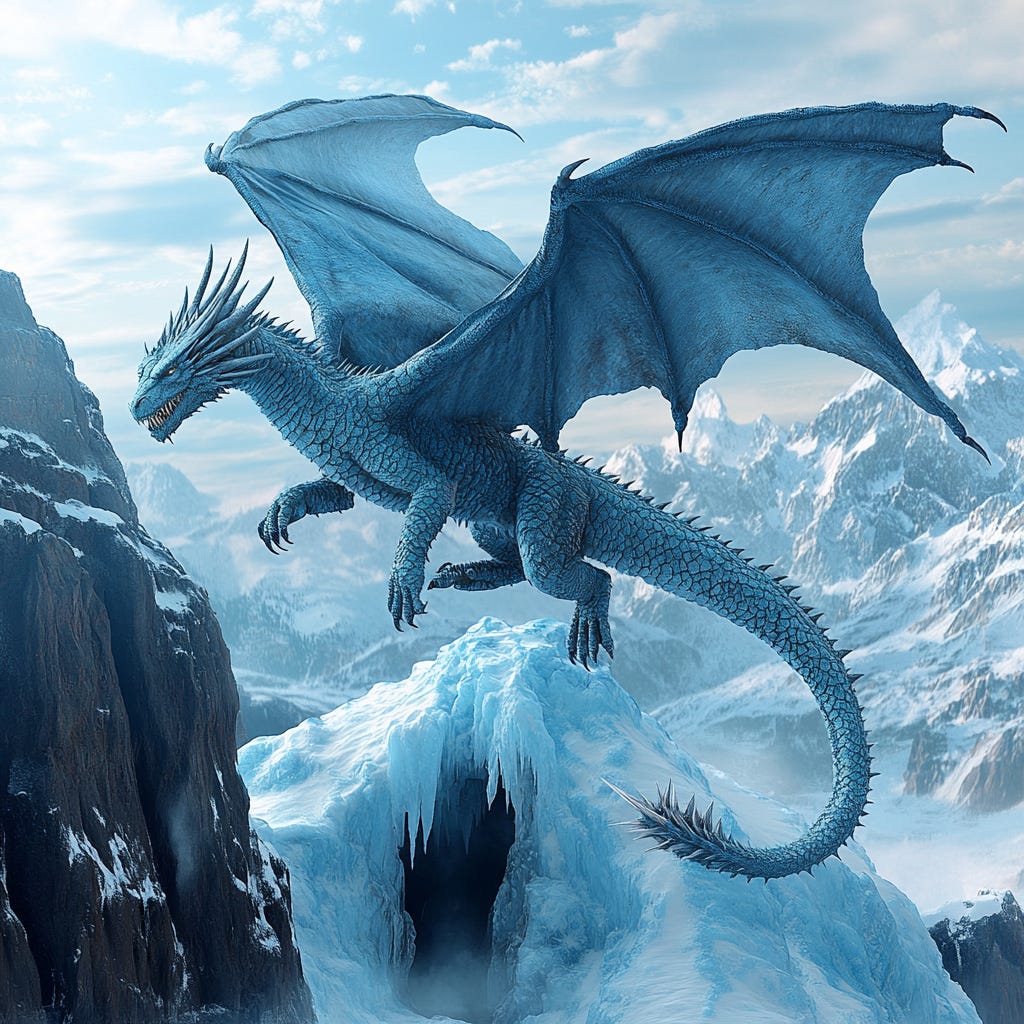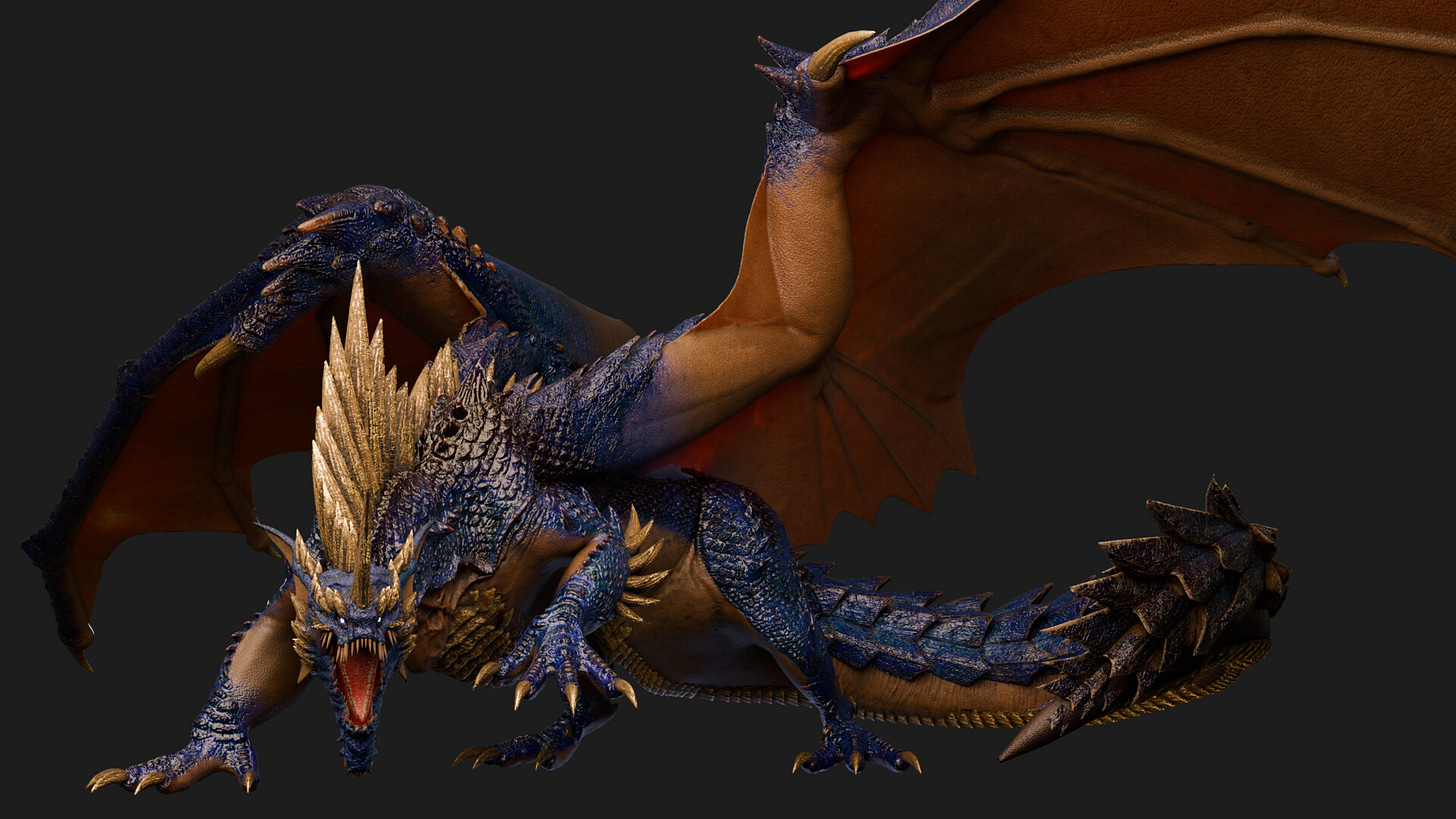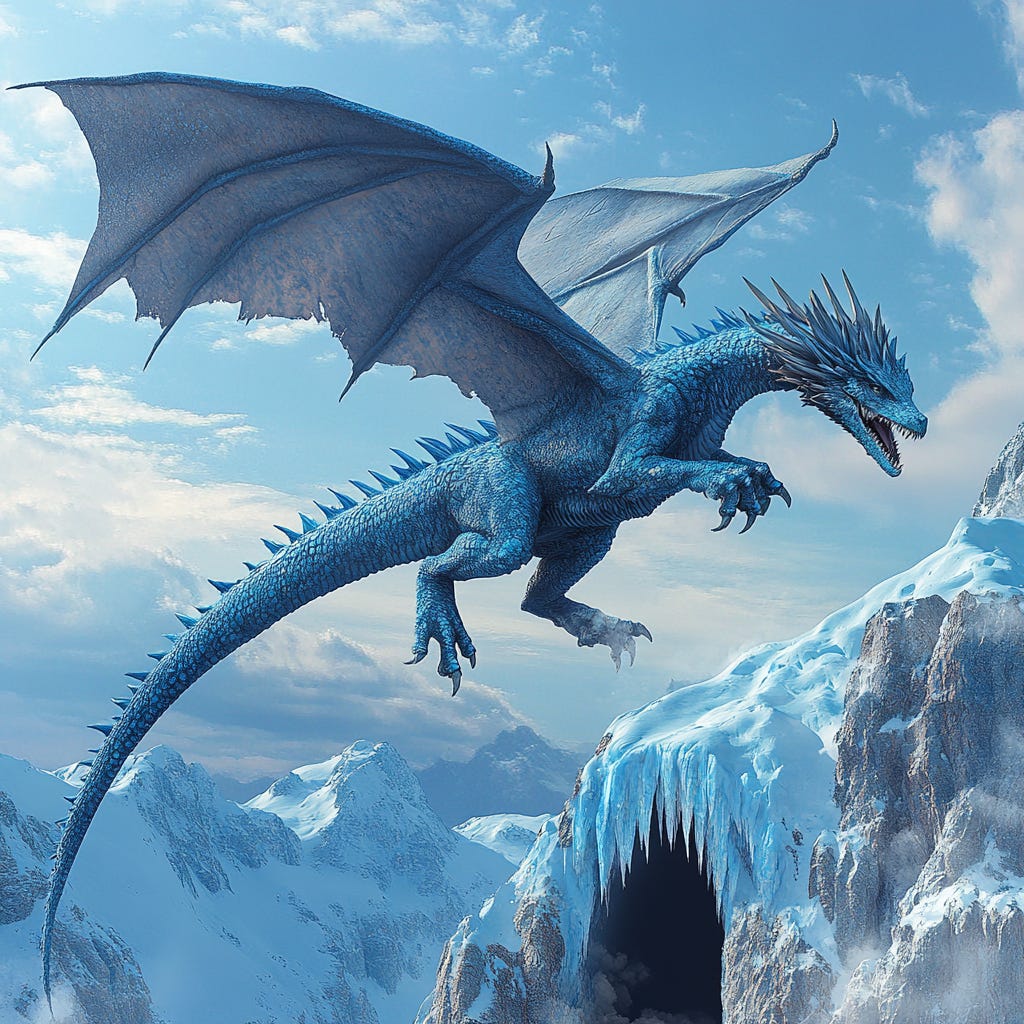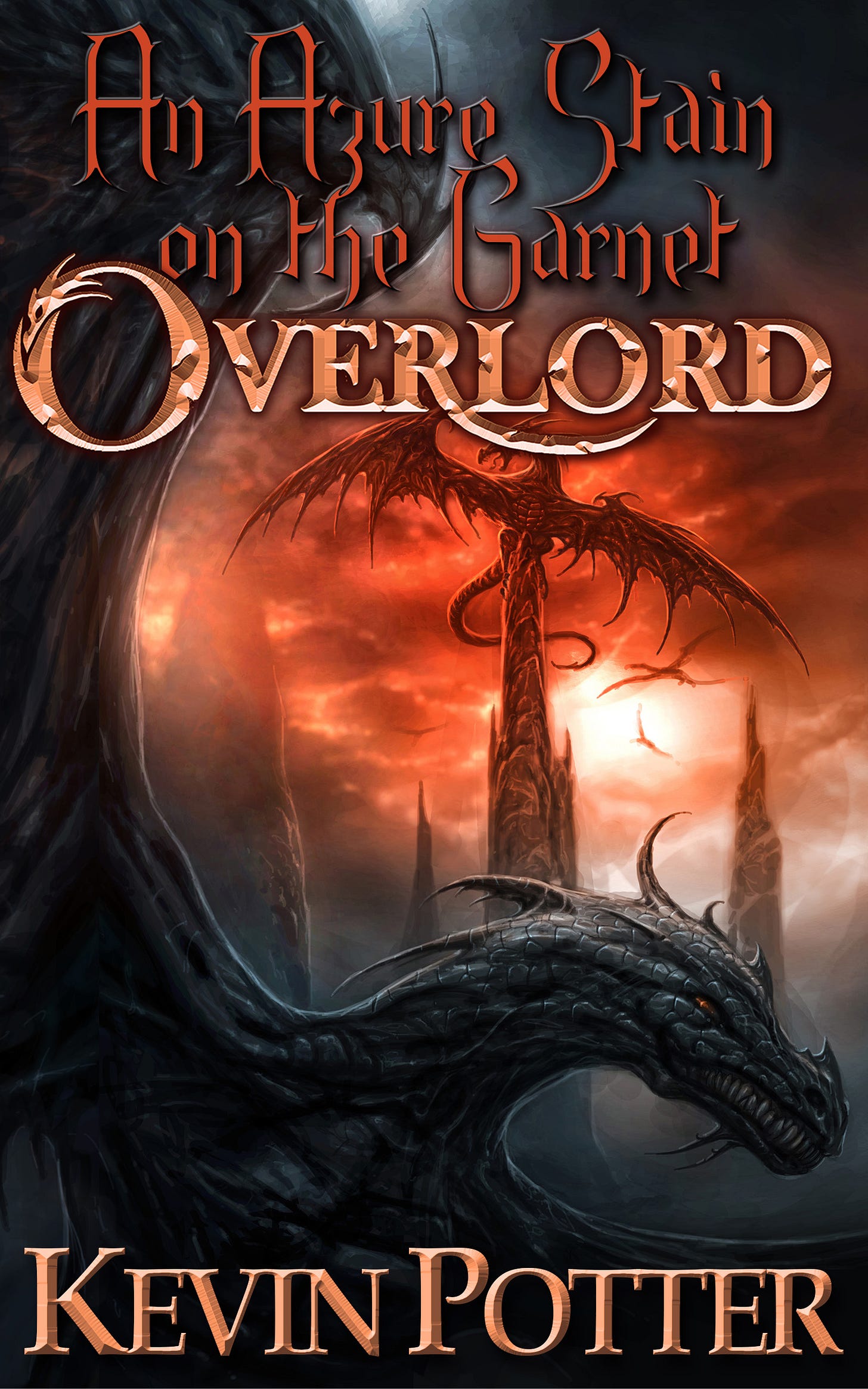Hello my friend!
Today, I’m starting a new series for the newsletter that I’m hoping will be exciting for my fellow dragon enthusiasts. In the past I haven’t put down in print very much about the dragons of my worlds. Most of the details of their lives, attitudes, ecology, etc has been in my head but never more than that.
Well, that’s going to change starting today.
For those reading this in email, I highly recommend getting the Substack app. It’s a great reading experience, has some lite social media elements that are super fun, and allows you to see my full posts no matter how long they get! No to mention that for my audio people, I include voiceovers of my posts that are only available in the app.
The first thing to recognize (and most who’ve read even one or two of my books probably know this already) is that I have four distinct categories in which I organize dragon breeds.
Metallic dragons, encompassing Silver, Gold, Bronze, Brass, Steel, Copper, Iron, Pyrite, and Platinum (though these are in some respects a category all their own), These breeds are typically more benevolent and peaceful, as dragons go.
Stone dragons, including Garnet, Azurite, Agate, Malachite, Celestine, Hematite, Cobalt, Granite, and Charoite. These dragons tend to be more self-serving and aggressive than other dragons. They are also more prone to madness than other breeds.
Gem dragons, including Amethyst, Topaz, Emerald, Crystal, Ruby, Sapphire, Diamond, Opal, Tourmaline, and Alexandrite. These are those who typically fall between the two extremes of Metal and Stone. They tend to be more controlled, logical, and thoughtful than other dragons. As such, they have a tendency to end up in positions of arbitration or judgement and in conflicts tend to side with whomever will end up causing the least harm to the least number of souls.
Unclassifiable. These are dragons who do not fall within any class of species. They include such oddball breeds as the Shadow dragon, Sand wyrm, Sea dragon, Dragon Turtle, Bark dragon, Fire wyrm, Ice wyrm, Rock wyrm, and Spirit dragon. As one might expect, there is no analog tying these breeds together except their inability to be classified. There are no commonalities of organization, physiology, or attitudes that link them.
Naturally, anyone with a D&D background will see there is an obvious correlation to how I organize my dragon breeds. And you aren’t wrong! Now, I don’t see them as quite so harmonious or homogeneous as they are presented in that particular game. And obviously I have more different types than any D&D material I’ve ever read. But, of course, considering how young I was when I first discovered D&D, many of the elements I was exposed to then (AD&D 2nd Edition, if you’re curious) have gone on to inform a significant part of my fantasy world view.
Now.
At least once each month I’m going to be sharing an article that is all about one specific species of dragon. And to start it off, I’m going to talk about one of my personal favorites, the Azurite Dragon.
If you are one of the few who has been with me from the beginning, you’ll probably understand why. It goes all the way back to my very first published work, which is a novella that is no longer available (except in audio and perhaps a few extant copies of the paperback floating around somewhere). These days I’m not terribly proud of that first publishing venture, so don’t fret if you never had the chance to read it. Especially since the story it told is going to be rewritten as book 6 of Blood of the Dragons.
But anyway, to make a long story short I had an Azurite dragon in that story that I absolutely fell in love with. It was an opportunity for me to play with the idea of having a main character who really isn’t terribly effective. He was physically crippled, which made his life extremely complicated. And he was in an awkward societal situation, being in the personal service of an Overlord, which naturally made him quite hated by the populace at large. And he may or may not have been some degree of autistic.
But for all that, he rose above his humble beginnings and his shortcomings to bring people together and do what needed to be done. In short, he was exactly my kind of non-heroic hero.
But anyhow, enough about that. Without further ado,
AZURITE DRAGONS

I’m sure it will come as no surprise to most that my Azurite dragons are pretty heavily inspired by the blue dragons of Dragonlance. I grew up on the Dragonlance novels and they were foundational for me. A lot of my sense of honor and ethics came from those authors.
If anyone reading this has NOT experienced Dragonlance, I highly suggest you fix that as soon as possible! If that’s you, let me know and we can talk about the best place to begin. I recognize that it can be daunting to start delving into a series that has over 200 books and still has new ones being published.
To get back on track, let’s talk…
Habitat
Azurite dragons are a bit of a contradiction in terms of where they prefer to live. They are one of the few dragon breeds that are equally comfortable in both warm and cool weather environments. You could find one slumbering in the packed snow of an ice-capped mountain peak or sunbathing on the glaring white sand of an intensely hot desert.
Some members of the breed will flip-flop between those two extremes, while others will have a definite preference for one over the other. But few dragon breeds show this much variance in the type of environments the enjoy.
Outside of those preferences, like most dragons they prefer to lair within stone caves that can be natural or created. Azurite dragons are significantly more likely than other breeds to have a fondness (or in some cases demand) for lairs that are either natural are carved out by hand (claw?). Which is not to say that they are opposed to the use of arcane energies in general. They tend to possess as much arcane strength as most other dragons. It is more than in their living spaces, they tend to be purists.
Size
Being one of the (typically) larger of the dragon breeds, Azurites begin life about the size of a medium wolf (3-5 feet long, with an additional 2-4 feet for their tail) and can eventually grow into proportions that are truly colossal. An average young adult will be from 25-40 feet in length, plus an additional 15-25 for their tail.
The eggs of Azurite dragons strongly resemble the stone for which they are named, but typically stand 3-4 feet in height with a typical egg-like (oval) shape. Some are lustrous and shiny while others are duller with a matte finish.
Reproduction
As with most dragons, Azurite dragons reproduce in a hybrid cycle that resembles both avian and mammalian reproduction throughout its cycle.
Dragon reproductive organs are internal for both males and females, but when their hormone levels are sufficient for mating both male and female sex organs are revealed, allowing the sexual mating process which will result in the fertilization of a number of eggs held within the female’s body. She will carry those eggs for a period of 20-24 months while both the eggs and the embryos they contain grow to sufficient maturity that the eggs reach their full size, containing enough internal material to feed the embryo until it reaches the developmental stage that will allow it to break free from its egg. The dam will lay the clutch of eggs clustered together in a warm location, usually at least partially buried to protect them from scavengers who might otherwise steal away the egg for an easy meal. After the clutch is laid, the eggs will incubate for an additional 8-12 months.
The variance in gestation and incubation falls largely to the relative warmth of the eggs and the physical stress of the dam. The more stress she experiences during gestation, the longer the gestation period will be.
Organization
Unlike most other Stone Dragon species, Azurites are known for coexisting in extended family groups and even incorporating those of other families or (in rare instances) those of other breeds. And also unlike most other breeds of Stone Dragons, they typically mate for life. It it unusual for an Azurite whose mate has died to move on to a new mate. The sheer attachment they form with their bonded mate is such that most could not fathom trying to build an attachment with another. The most common exception to this rule is if the pair has not been mated for very long (less than a century).
Physiology
As with all Stone Dragons, Azurites strongly resemble the stone for which they are named. Their scales are pale and translucent at hatching, and grow more opaque and darker the older they get. As with all dragons, their scales become thicker, harder, and more interlocked with one another as they grow older.
Like all true dragons, they have six limbs (seven if you could the tail); four legs and two wings. Only wyverns and proto-dragons or pseudo dragons have only hind legs and wings.
Azurite dragons are equally likely to have spinal spikes or ridges and horns. Most who have horns have sets of either two or four rising from near the crest of their heads, though alternate formations have been recorded.
Their tails tend to end in either razor-sharp blades or balls of spikes that angle out in all directions. They are fall less likely than others to have a simple tapering tail or one that ends in a blunt mass (like the ball that tips an ankylosaurus’s tail).
Like all true dragons, Azurites possess a natural elemental breath. There is no element of the arcane to this breath. Every dragon possesses an internal organ called a Golar that exists in close proximity to their lungs. The Golar consists of two separate sacs, similar in form to the venom sac of a venomous snake. When breath is cycled through the Golar, it activates the two sacs together, which combines the elements found within and thereby creates the elemental explosion known as Dragon’s Breath.
Although some dragon breeds have more than one Golar, allowing them different types of breath, the Azurite is not among them. Their breath comes in the form of a blast of lightning that strongly resembles the color of their scales.
Of all dragons, those with lightning elemental breath are among the most devastating when unleashed against a structure or single target.
Dragon’s blood and tears both contain qualities similar to the dragon’s elemental breath, though to significantly lesser degrees. And the tears significantly less than the blood. In the case of the Azurite, both the blood and the tears smell and taste of the burning ozone that is a hallmark of natural lightning. They also have an electric, crackling quality that can cause severe burns to fragile flesh/substances when coming from an older dragon.
Personality
Although all dragons, like humans, are unique individuals, we can speak of some general tendencies here. While being just as prone to bouts of cruelty and aggression as other Stone Dragons, Azurites tend to be more controlled about it. The feral chaos that tends to exemplify other Stone breeds is largely absent from these. They are every bit as known for megalomania as others, but are not nearly so fond of wanton destruction as some other Stone Breeds. They are also much more likely to form attachments to non-dragon beings that manage to prove their worth to the Azurite.
Combat
Like other dragons with particularly destructive elemental breath, these wyrms prefer to restrict themselves to their natural weapons and focused uses of arcane power to dispatch their enemies. They generally will only resort to their lightning breath when facing a more powerful opponent or if they are overwhelmed by sheer numbers. Owing to their size, many are fond of utilizing their tails as devastating weapons.
Creation Story
Most Azurite dragons believe the creation story that is (mostly) common to Stone Dragons:
In the beginning, the Earth was void. Ryujin, Tiamat, and the Astral Dragon came together to forge a world where only nothingness had been. At this time, Ryujin and Tiamat were lovers. After the world had been made and was populated with the base animals and vegetation, the trio came together to forge their greatest creation: beings forged in their own image.
With help from the other two, Tiamat sculpted nine dragons out of the base stones of the world; Garnet, Azurite, Agate, Malachite, Celestine, Hematite, Cobalt, Granite, and Charoite. She infused them with her own chaotic and powerful essence and immediately they sprang to live, eager to serve their mistress, the Lady of Chaos.
Ryujin and the Astral Dragon quickly became jealous and set about, in secret, to construct dragons of their own to rival Tiamat’s, but they were pale imitations. None were equal to even the weakest of the Lady’s children. But even so, the comparisons began and conflict soon followed.
Thus began the rift between the lovers that grew to a chasm and then an uncrossable divide. Following that separation began the skirmish battles between the dragons of Stone, Metal, and Gem.
These were put to rest only when there was a greater threat to them all that had to be dealt with; the first wave of human Dragon Slayers that rose up to challenge them.
Once their concerted efforts began, putting down the Slayers was a relatively simple matter, especially since the Stones were working in such a coordinated fashion. They often had to come to the rescue of the Metallic and Gem dragons until eventually, still long before any of human history was recorded, the Dragon Slayers were eliminated and treaties were formed with all of Humankind to prevent them from attempting to control or destroy Dragonkind ever again.
And now it’s over to you, my friends. What are your thoughts on my ideas of Azurite dragons? Anything you would change? Anything you think I need to add to this? Let me know in a comment.
And as always, if you know anyone who would enjoy my content, feel free to refer them to my publication!
And finally, it’s time to get excited!
I have a brand new piece of short fiction that I’m going to be sharing for the first time next week to my paid subscribers!
Here’s what an early reviewer had to say about it:
“The world is vast, with lore, history, and a deep sense of place—but it’s delivered entirely through character. The author knows these dragons he's written—not just their cultures, but their mindset, philosophy, and even intricate details about their biology. Every detail is grounded, yet still lives comfortably in the classic fantasy tradition. It walks that line well.”
Description:
Terrifying dragons rule the Earth.
Khell is a small, crippled dragon who desperately wants to protect his friends. He serves a terrifying Overlord but dreams of the freedom of all dragons everywhere. But when his friend insists on openly defying the Overlord, Khell is forced to choose between his loyalty to his friends and his will to survive!
Faced with the horrors of his reality, Khell must find a way to harden his heart to the terrors of his existence. Between the Overlord's ability to read his thoughts and his sadistic sister who's willing to sacrifice anything, including him, to advance, he has his work cut out for him.
Can Khell overcome all obstacles and free those he loves, or is he doomed to the fate of the martyr?
An Azure Stain on the Garnet Overlord is a standalone story that takes place late in the Blood of the Dragons sequence and is guaranteed to keep you flipping pages until you reach its thrilling conclusion!
Upgrade your subscription now to ensure you can read the story as soon as it drops next week!
Or, alternatively, if you’re not willing to wait or if you just want to be able to download the story, you can buy it now on Curios in ebook and audio:











